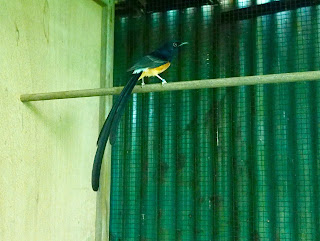Following my Facebook post on the conditions
that are required for the captive shama to have a good molt, Harnono Taufik
asked about “mastering” during the molt. Mastering or “masteran” is a system used in Indonesia to teach captive shamas to
learn new songs. Greenleaf birds, lovebirds, canaries and other songbirds are
placed close to the shama during its molt to be song tutors for the shama.
The molt is a quiet time for the shama as it goes
through the arduous process of getting a new set of clothes and it is a good
time for it to learn new songs. However,
it is quite capable of learning new songs at other times. The shama, as a species, is classified as an “open ended learner” i.e. it has the ability
to learn new songs throughout its life. This is well borne out by my captive-bred
15 years old shama, Ballet Dancer, who readily learns new songs and can
surprise with a song that I may never have heard.
Another thing to note is that the songs are
learnt and sung over months or years, or, sometimes for only a short period and
never heard of again or it may re-emerge at a much later date.
Most Indonesian shama hobbyists are
interested only in its song and nothing else matters. The bird’s structure,
display, feather condition and tail length have no bearing in the competitions
that they hold. Competitions may last for only 20 mintues with points awarded
solely for the variety of the bird’s song with more points being awarded for
the more desirable songs such as that of the lovebird.
In other parts of South East Asia, the
hobbyists are interested not only in the shama’s song but also in its display
and a competition may last for 1½ hours or more. This is where the shamas with longer tails
can put up a more eye-catching display as they wave their tails.
Since the contests are not judged solely on
the bird’s song, hobbyists in Singapore, Malaysia, Thailand and Vietnam do not have
a practice of mastering their birds in the way the Indonesians do. In these
countries, the shama tends to sing its “wild”
song i.e. the song that it learnt while in the forests or that it picked up
naturally in captivity. Many hobbyists in these countries in fact prefer such
song to the trained song of some Indonesian shamas.
While we do not specially train our shamas to
sing, there is no reason to think that they are any the less capable of
learning songs than the Indonesian shama.
My early mentor on shamas, Mr. John Yim was an accomplished whistler and
used to whistle the opening parts of the “Happy
Birthday” and “Bridge on the River
Kwai” songs to his birds. The result
was that they learnt to whistle these tunes with surprising accuracy.
Below is a photo of DDS418, partway through his first molt.

No comments:
Post a Comment